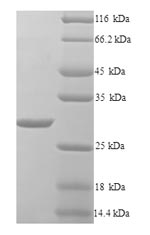Recombinant Klebsiella pneumoniae Beta-lactamase SHV-1 (bla) is produced in a yeast expression system, which appears to provide a reliable source of this enzyme for research applications. The protein gets expressed as the full-length mature form, spanning amino acids 22 to 286. It features an N-terminal 6xHis-tag for easier purification. With a purity exceeding 90% as determined by SDS-PAGE, this product may ensure high-quality results for experimental needs.
Beta-lactamase SHV-1 is an enzyme that likely plays a crucial role in bacterial resistance to beta-lactam antibiotics. It works by breaking down the antibiotic molecules and neutralizing their effects. This protein belongs to the larger beta-lactamase family, which has become significant in studies related to antibiotic resistance mechanisms. Understanding the structure and function of SHV-1 might aid in developing strategies to combat antibiotic-resistant bacterial strains.
Potential Applications
Note: The applications listed below are based on what we know about this protein's biological functions, published research, and experience from experts in the field. However, we haven't fully tested all of these applications ourselves yet. We'd recommend running some preliminary tests first to make sure they work for your specific research goals.
Klebsiella pneumoniae SHV-1 beta-lactamase is a bacterial enzyme that requires precise folding, active site formation, and proper disulfide bond formation for its catalytic activity against beta-lactam antibiotics. The yeast expression system provides a eukaryotic environment that supports proper protein folding and disulfide bond formation, increasing the probability of correct folding compared to bacterial systems. The N-terminal 6xHis tag is relatively small and unlikely to significantly interfere with the enzyme's active site or functional domains. While yeast expression provides favorable folding conditions, experimental validation remains essential to confirm functional enzymatic activity.
1. Biochemical Characterization and Enzyme Kinetics Studies
This application is highly dependent on proper folding validation. Beta-lactamase activity requires precise tertiary structure formation. If correctly folded (verified), the protein is excellent for determining kinetic parameters, substrate specificity, and inhibition profiles with various antibiotics. If misfolded/unverified, enzymatic assays will yield inaccurate or negative results, providing misleading biochemical data.
2. Antibody Development and Immunological Studies
Antibody development relies primarily on antigenic sequence recognition. If correctly folded (verified), the protein excels for generating conformation-sensitive antibodies that recognize native beta-lactamase epitopes. If misfolded/unverified, it remains suitable for producing antibodies against linear epitopes, which are still valuable for detection applications.
3. Protein-Protein Interaction Studies Using His-Tag Affinity
This application requires proper folding validation. If correctly folded (verified), the protein can identify physiological interaction partners involved in beta-lactamase regulation or cellular localization. If misfolded/unverified, there is a high risk of non-specific binding or failure to identify genuine interactions.
4. Inhibitor Screening and Drug Discovery Research
Functional screening requires native enzyme activity. If correctly folded (verified), the protein enables valid high-throughput screening for beta-lactamase inhibitors. If misfolded/unverified, screening assays will yield false positives/negatives, making results unreliable for drug discovery.
Final Recommendation & Action Plan
The yeast expression system provides favorable folding conditions for this beta-lactamase, but experimental validation of enzymatic activity is essential before functional applications. Begin with biochemical characterization to validate folding and activity using standard beta-lactamase substrates (e.g., nitrocefin) and determine kinetic parameters. Once correct folding and functional activity are verified, proceed confidently with Applications 1, 3, and 4 for enzyme kinetics, interaction studies, and inhibitor screening. Application 2 (antibody development) can proceed immediately regardless of folding status. If misfolding is detected, limit applications to linear epitope antibody production and basic biophysical characterization, avoiding all functional studies. For reliable beta-lactamase research, always include appropriate activity controls and substrate specificity tests in experimental designs.






